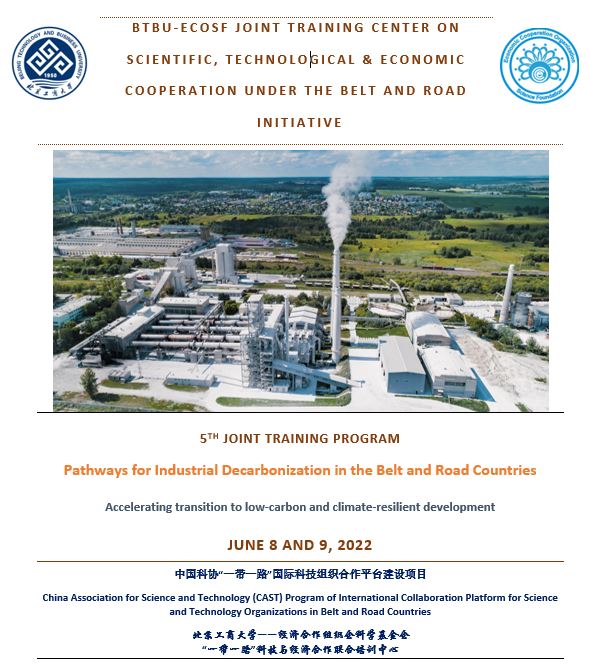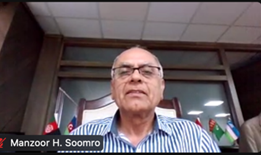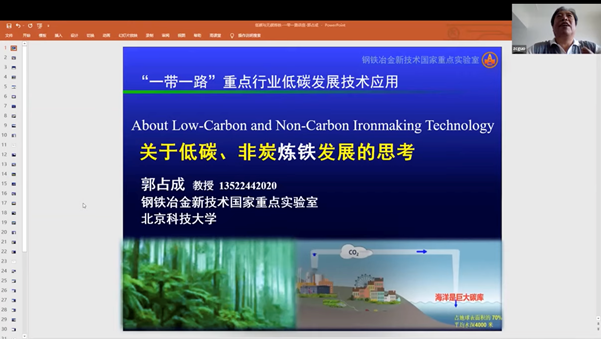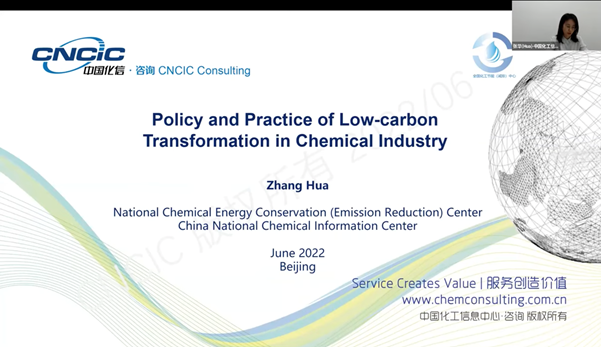BTBU-ECOSF Joint Training Center hosted its 5th Training Program- Pathways for Industrial Decarbonization in the Belt and Road Countries
Go Back


BTBU-ECOSF Joint Training Center with support of China Association for Science and Technology (CAST) organized the 5th joint Training Program on Pathways for Industrial Decarbonization in the Belt and Road Countries on June 8th and 9th, 2022. The training workshop brought together industrial experts, representatives of industrial corporations, policymakers and supporting organizations to develop and share energy efficiency and low carbon best practices in the industries. The purpose of this training program was to accelerate to low-carbon and climate-resilient development with special focus on key industrial sectors, including cement, steel, chemicals, coal, and transportation.
The virtual training attracted participation of over 200 participants from about 15 countries, particularly from the ECO Member Countries. It is important to note that this was the second training session dedicated to low carbon development for BRI, previously the Joint Training Center held the similar training session on low carbon development last year in June 2021. This training workshop was moderated by Dr. Di Yuna, head of the BTBU-ECOSF Joint Training Center and Engr. Khalil Raza Scientific Officer – ECOSF.

Climate Change is the biggest risk to mankind and one of the greatest global challenges of the 21st century, which needs to be addressed through international cooperation in the context of sustainable development. China has emerged as global climate leader with its announcement in 2020 that the nation would aim to achieve “carbon neutrality” by 2060. China already leads the world in the clean energy technologies, and it is by far the largest investor, producer and consumer of renewable energy.
Most of the world’s focus has rightly been on today’s major emitting countries when it comes to fighting the battle with climate change. From a forward-looking perspective, however, the biggest climate risk and opportunity lies in our ability to support a low carbon development pathway for the Belt and Road Countries that have signed up to China’s Belt and Road Initiative (‘BRI’). Hence, BTBU-ECOSF Joint Training Center made an attempt to bring China’s extensive expertise and best practices in low carbon development to other Belt and Road (B&R) countries to host its 5th training program entitled on “Pathways for Industrial Decarbonization for the Belt and Road Countries” on June 8-9, 2022.
The purpose of this training program was to accelerate to low-carbon and climate-resilient development with special focus on key industrial sectors. It is important to note that this was the second training session dedicated to low carbon development for BRI, previously we held the similar training session on low carbon development last year in June 2021.
In this backdrop, this training program sought to understand and learn about viable options for low carbon transition, best practices, success stories, and barriers on implementation of policies and programmes promoting low carbon development, and match the potential cooperation among BRI counties in clean energy, charging station and new energy vehicles.
 Prof. Dr. Manzoor Hussain Soomro, President ECOSF in his welcome remarks emphasized that Science, Engineering, Technology, and Innovation (SETI) play a critical role in providing policy instruments that are essential to develop strong base of countries. Prof. Soomro underlined that it is important to deliberate on the adequate framework and strategies to develop the STI policies as a powerful governing tool which can reshape and alter the course of direction towards a high economic growth trajectory for the Belt and Road countries.
Prof. Dr. Manzoor Hussain Soomro, President ECOSF in his welcome remarks emphasized that Science, Engineering, Technology, and Innovation (SETI) play a critical role in providing policy instruments that are essential to develop strong base of countries. Prof. Soomro underlined that it is important to deliberate on the adequate framework and strategies to develop the STI policies as a powerful governing tool which can reshape and alter the course of direction towards a high economic growth trajectory for the Belt and Road countries.
Prof. Soomro underscored that BRI of China commits to foster the industrial development with strong technical cooperation in many fields, including sustainable energy, infrastructure development, emerging technologies, and smart cities or transport etc. To achieve these massive goals, it requires a robust commitment to support science and engineering, including the capacity building and human resource development, Prof. Soomro remarked.
Prof. Soomro said that we are very well aware of that the impacts of climate change that are occurring with increasing severity and frequency. All nations are vulnerable, but generally, developing countries are even more vulnerable and less resilient with limited resources for both mitigation and adaptation. This situation calls for the urgent need for us to make more investments in technologies and processes to promote climate-smart solutions for our planet.
President ECOSF further said that it is very timely to discuss low carbon industrial development, as aggressive adoption of such technologies will be an essential prerequisite for the Belt and Road region to collectively move closer to the more ambitious target to reducing the GHG emissions and containing the increase in temperature.
Policies and practices for low-carbon transition in the Coal Power Industry.

ZHU Fahua, Deputy General Manager, Science and Technology Research Institute Co., China Energy Investment Corporation (China Energy) delivered his lecture on the Policies and practices for low-carbon transition in the Coal Power Industry.
Mr. Fahua outlined that China has adoptend an stringent focus on reducing the total amount of fossil energy, focus on improving utilization efficiency, implement renewable energy alternative actions, and deepen the power system innovation. He underlined that the importance of coal power in maintaining the security of the national power supply and the stability of the grid is irreplaceable for China at present. Hence, the low-carbon transition must be coordinated with supplies guaranteed, making a large-scale expansion of renewables possible, while avoiding emissions cuts or indiscriminate cutting back on power consumption.
Mr. Fahua underlined that the 14th Five Year Plan (FYP) period (2021–2025) as an important policy directive for laying a foundation on which China can achieve its dual carbon targets, of peaking before 2030 and neutrality before 2060.
To achieve the goal of carbon neutrality, the low-carbon transition paths of coal power for each province are extremely critical in the context of China’s emission trading scheme (ETS). He further highlighted importance of energy security and the role of coal and coal power in ensuring it: coal is to provide stronger energy guarantees, coal power will have a “supportive” role, and the “clean and efficient use of coal” is to be encouraged. He said that FYP provides clear roadmap on China’s efforts to decarbonize its energy system and it outlines systematic instructions for a “green and low-carbon energy transition” – a key step for China to peak carbon emissions before 2030 and achieve carbon neutrality before 2060. Mr. Zhu Fahua concluded that fossil fuels should only be replaced when renewable energy supplies become reliable.
Policies and practices for low-carbon transition in the cement industry.

LI Yeqing, Executive Vice President, China Building Materials Federation (CBMF) presented his insights on the Policies and practices for low-carbon transition in the cement industry.
Mr. Yeqing said that the cement industry is regarded as one of the most energy-intensive sectors, which generates large amount of greenhouse gas and pollutant emissions. Therefore, the realization of green development of cement industry is of great significance for industrial decarbonization.
Globally, cement industry is under tremendous pressure to reduce the carbon emissions. Traditional cement industry has a very high carbon footprint. In the cement production, a large amount of limestone, coal and other nonrenewable resources are consumed, and greenhouse gases are produced, and other pollutants are emitted. Globally the cement the industry accounts for 7% of total CO2 emissions and whereas the coal consumption represents 5% of global CO2 emissions.
Mr. Li Yeqing highlighted that the National Development Reforms Commission (NDRC) issued Action Plan for Key Industries of Metallurgy and Building Materials to promote Energy Efficiency, push energy savings and carbon reduction (Year 2021-2025), which outlines main goals for industries including cement. It requires the capacity with advanced level of major industries including cement and data center must exceed 30% in 2025, by means of implementing energy saving and carbon reduction actions.
There are multiple potential ways to decarbonize the cement industry. This could be done using a combination of carbon capture and storage (CCS) and fuel and intermediate product substitutes. Besides, using alternative fuels in clinker production can reduce the use of fossil fuels, reduce emissions of CO2 and other polluting gases, reduce the shortage of land caused by landfill, save investment in new waste disposal sites, and have great energy saving, emission reduction and economic and environmental benefits.
Alternative fuels such as Municipal Solid Waste, have a lower CO2 emission factor than conventional fuels and can reduce the amount of CO2 emitted by the disposal of these alternative fuels. In addition, the synergistic disposal of cement kilns can also reduce methane emissions from landfills. About 60% of the gas emitted from landfills is methane gas, which has 21 times the potential of CO2.
Policies and practices for low-carbon transition in the steel industry.

GUO Zhancheng, Professor, State Key Laboratory of New Technologies of Iron and Steel Metallurgy, University of Science and Technology Beijing delivered his lecture on policies and practices for low-carbon transition in the steel industry
Mr. Zhanchang said that steel industry occupies a place as one of the most important materials in modern life. Making steel is also highly carbon intensive. Making one metric ton of steel results in 1.8 metric tons of CO2 emissions, on average, and steel production accounts for about 8 percent of global CO2 emissions.
Steel is one of the core pillars of today’s society and, as one of the most important engineering and construction materials, it is present in many aspects of our lives. However, the industry now needs to cope with pressure to reduce its carbon footprint from both environmental and economic perspectives.
Currently the steel industry is among the three biggest producers of carbon dioxide, with emissions being produced by a limited number of locations; steel plants are therefore a good candidate for decarbonization. While the industry must adapt to these new circumstances, it can also use them as a chance to safeguard its license to continue operating in the long term. Indeed, all Indeed, almost all Chinese steel producers are currently developing decarbonization strategies and running pilot plants to assess different production technologies.
Policies and practices for low-carbon transition in the chemical industry

ZHANG Hua, Secretary General, China National Chemical Energy Conservation (Emission Reduction) Center (CNCECC).
Ms. Hua underlined that the Chinese Government has put high emphasis on decarbonizing the major chemical industries to achieve the carbon neutrality targets. Hence, the state authorities are promoting the carbon peak of the petrochemical and chemical industry. This requires the optimizing the scale and layout of the production capacity and intensify the elimination of backward production capacity.
For emerging industries with large energy consumption, industrial associations and government institutions are supporting and guiding enterprises to apply green and low-carbon technologies to improve the energy efficiency. China launched an action plan which provides a strict energy efficiency target and highlights key areas in petrochemical and chemical industries to promote energy conservation and carbon reduction process by 2025.
Case study: Low Carbon Transportation in BRI Countries

Engr. Khalil Raza, Scientific Officer, Economic Cooperation Organization – Science Foundation (ECOSF)
Mr. Raza presented a policy framework to scale up electric mobility in Pakistan and other ECO Member Countries. Mr. Raza concluded in order for Pakistan to achieve its intended Electric Vehicles (EV) penetration targets, relevant stakeholders need to strengthen its policy intervention in four key areas; (a) robust strategy (b) financial incentives (c) plan for reducing the cost of lithium-ion batteries and (d) adequate supply of reliable charging network.
It is important to mention that the transport sector of Pakistan is based entirely on imported fuels that is causing a major threat to country’s trade deficit. As of January 2022, the trade deficit of Pakistan surged to $24.79 billion in the first half due to 63% increase in year-on-year basis. In 2019, Pakistan had to spent over $13.3 billion dollars on import of oil, and this cost is expected to cross over $30.7 billion by 2025. In the backdrop of these challenges, a transition towards Electric Vehicles (EVs) can reduce Pakistan’s dependency on the petroleum products & at the same time provide a decarbonization pathway that goes beyond just the power sector. In pursuant of this goal, Pakistan launched its first Electric Vehicles Policy in 2019 which aims to achieve 30% share in sale of EVs by 2030.

Prof. Liu Minhua Vice President, Beijing Technological and Business University (BTBU) gave his closing remarks towards the end of training workshop. Prof. Minhua concluded that transformative powers of Science, Technology and Innovation (STI) will be at the heart of industrial decarbonization in the Belt and Road region. Prof. Minhua paid her gratitude to the expert trainers from China and Pakistan for delivering important and resourceful training for the audience.
Prof. Minhua concluded that the successful transition towards low carbon development would heavily depend on fostering public-private partnerships that can accelerate deployment of technologies, promoting research and development, and human resource skills development. Hence the critical challenge for us is to enable delivery of our national development visions and goals – through low-carbon, climate-resilient or climate-compatible development plans and strategies, whereby the role of science and technology is overarching and gigantic.
He assured robust cooperation and collaboration will continue by the Joint Training Center to achieve the intended goals and promote emerging trends in industrial development and STI in the belt and road region.
Clikc here to view full report.
The recording of the entire training session is provided at the ECOSF’s YouTube at: